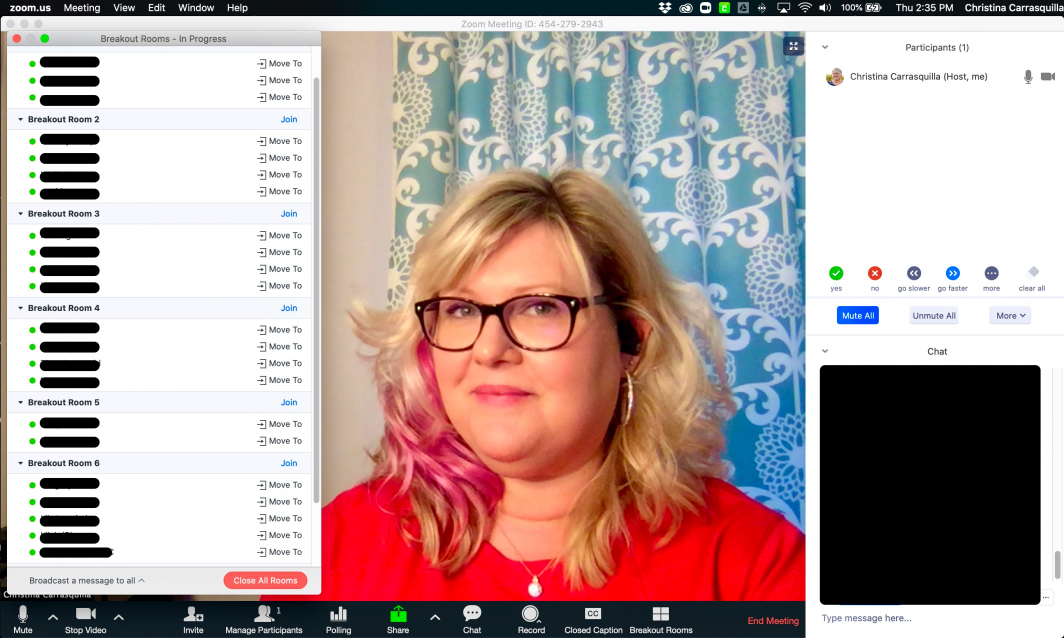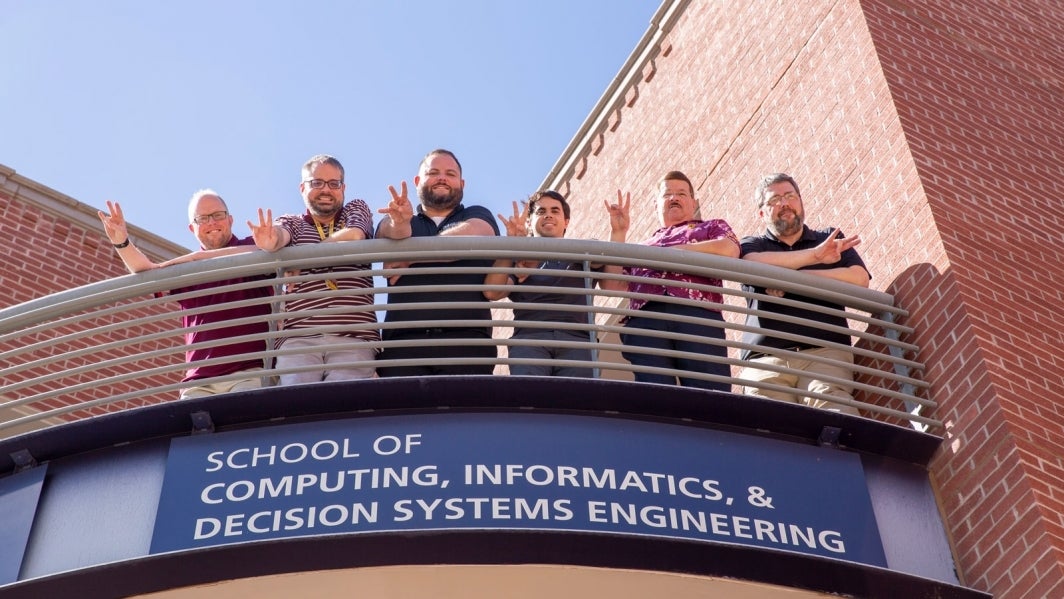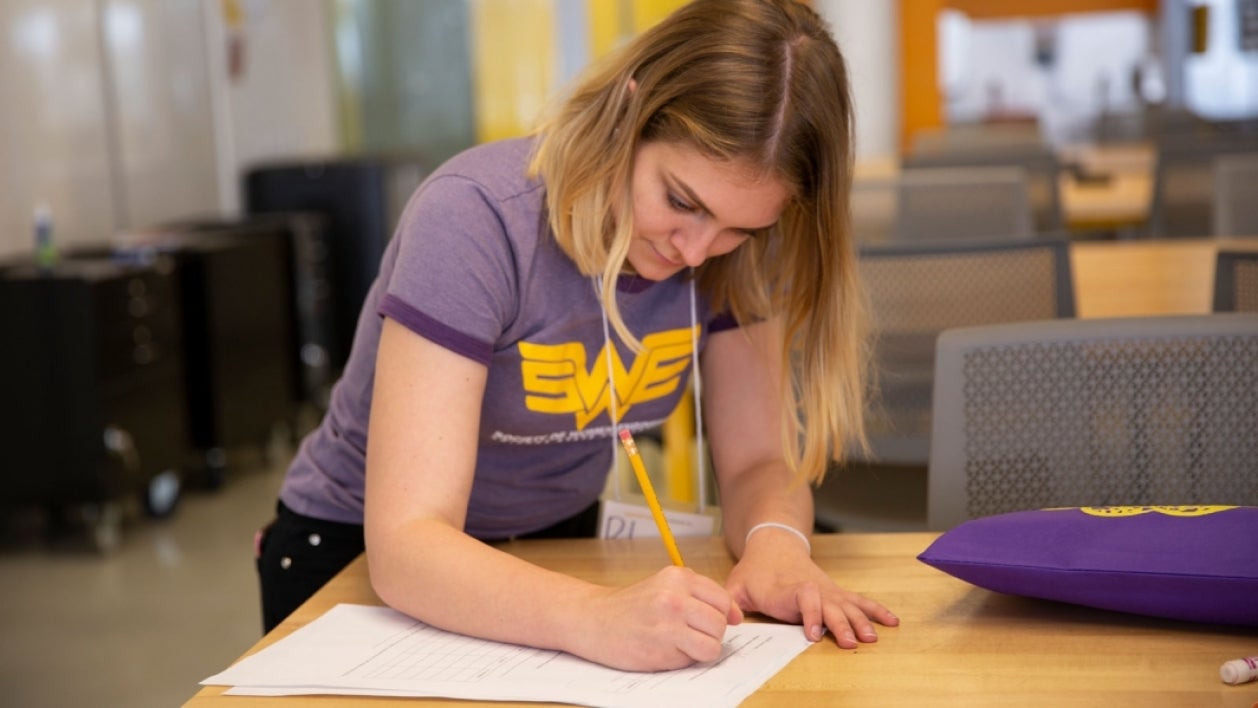ASU engineering schools find success in a new digital environment

In the wake of the COVID-19 pandemic, Arizona State University transitioned all in-person classes, advising and other services and activities online. Faculty and staff in the Ira A. Fulton Schools of Engineering at ASU have found engaging and effective ways to carry on these activities remotely. Graphic by Rhonda Hitchcock-Mast
Coming back from spring break, students in the Ira A. Fulton Schools of Engineering at Arizona State University were faced with adjusting to a new normal.
In the wake of the COVID-19 pandemic and the need for physical distancing, ASU transitioned all in-person classes, advising and other student services, and community-focused activities to online delivery.
Students, faculty and staff members sprang into action — trying new things, finding solutions and adapting to a new mode of learning.
Establishing a successful digital classroom
The transition to distance learning might have some students missing the daily interaction with their peers, faculty and other university staff. However, the online video conferencing tool Zoom helps bring facetime to digital classes, while the instant messaging platform Slack encourages conversation within the ASU community. Nontraditional tools like the livestreaming platform Twitch have even helped some instructors keep their classes engaging.
On the first day of online course delivery, more than 15,000 ASU classes were taught on Zoom and 55,000 students logged in to attend their now-online courses. The numbers have been growing since they launched on March 16, with the Fulton Schools’ more than 24,000 students adding to that number.
Angelique Mowery, a fourth-year computer science major, finds that she prefers online classes, and has enjoyed attending her courses online in the past week.
“I feel like classes are much easier to focus on when they are online versus in person,” Mowery said. “I personally can learn more and focus better in this format.”
When students always have a front-row seat to the presentation and interruptions that can occur in large classrooms are minimized, instructors can get their lessons across more efficiently.
While many students and instructors haven't used tools like Zoom much before, Mowery’s instructors are helping her and her classmates be successful by posting reminders, extending assignments and also spending the first few minutes of the class going over any questions.
Jeffrey Kleim, an associate professor of biomedical engineering, is taking his classes to Twitch, a livestreaming platform popular with gamers.
"It was just happenstance that a friend was staying with me who is an accomplished film and postproduction graphics editor," Kleim said.
Dave Sarbell, who has worked at CNN and on many television shows and Hollywood movies over the past 25 years, helped Kleim set up a new classroom in his condo.
"When the lockdown occurred, he showed me how to convert my living room into a greenscreen studio with fairly minimal investment and how to broadcast live on Twitch.tv," Kleim said.
Kleim presents slides and walks around just as he would in class, while attendees participate in a live chat. While the chat interaction is difficult to monitor while lecturing, iterating is part of the process of the transition. He'll continue to work on the best way to deliver lectures and encourage effective engagement.
However, the results of this "trial by fire" have so far been well received by his students.
“The students are loving it,” Kleim said. "The site is normally used by gamers, so the students were all familiar with it."
Christina Carrasquilla, a senior lecturer of graphic information technology in the Polytechnic School, one of the six Fulton Schools, is no stranger to online learning. She completed most of her master’s degree online and has been teaching online courses for more than a decade.
With students making the abrupt transition to all online learning, Carrasquilla makes an extra effort to check in with how her students are doing.
“I start and end every remote lecture by asking the students how they are and if they’d like to share their experiences, both successes and challenges,” she said. “I think it’s validating to hear that others are having the same struggles and learning from tips and tricks the others have discussed.”
Carrasquilla notes that remote learning has synchronous elements that don’t often happen in class. To help facilitate learning class material, she has taken advantage of Zoom’s breakout rooms for group work and student interaction.
“The ‘raise hand,’ ‘yes,’ ‘no,’ ‘thumbs up’ and ‘thumbs down’ buttons actually give me more feedback than face-to-face classes,” Carrasquilla said.
The week has also involved a dose of fun, with opportunities to meet students’ families, roommates and pets.
“One student’s family had a dance party behind her and we all had a much-needed, good laugh,” Carrasquilla said.
Olivia Burnsed, a lecturer of biomedical engineering in the School of Biological and Health Systems Engineering, says online classes have led to her getting more feedback from her students and to giving them more individualized instruction.
After the first week of remote learning, she surveyed her BME 200: Conservation Principles class to see how students felt about the transition online.
“It felt more one-on-one than in class,” read one response to a question about what aspects of the class were most valuable.
Like Carrasquilla, Burnsed uses breakout rooms, which students say make it easier to ask questions and engage with teaching assistants.
“(Breakout rooms give students) a better opportunity to engage with the (teaching assistant) rather than wait for the TA to walk around the class and offer feedback,” another student said.
The screen sharing feature also gave students personalized attention to get help with assignments and share information with other students, TAs and Burnsed.
Instructors adapt exams with digital tools
Exams, a fundamental part of many university classes, are also still going smoothly for Keith Hjelmstad, President's Professor of structural engineering in the School of Sustainable Engineering and the Built Environment, one of the six Fulton Schools.
Hjelmstad typically gives mastery-based exam problems that involve pencil and paper calculations for CEE 213: Introduction to Deformable Solids and CEE 212: Engineering Mechanics II – Dynamics. With exams scheduled during the first week of the online transition, Hjelmstad worked with undergraduate teaching assistant Amanda Minutello and Lecturer Efthalia Chatziefstratiou to come up with a solution.
“Necessity is the mother of invention,” Hjelmstad said. “It seemed we had exactly one option and we did that.”
Hjelmstad thought it would be possible to use Zoom’s video conferencing to watch the 120 students split between the two classes work on their written exam. With a scanning app or smartphone camera, students would then be able to send their exam paper to the teaching team. They tested it and planned the process as much as possible before class time, even having students attend an optional Zoom session to test their systems.
During the online class period, Hjelmstad and his assistants watched the students to ensure there was no academic dishonesty, just as they would have done with an in-class exam.
“In many ways, I felt like I got a better view of the students than in an in-person exam,” Hjelmstad says. “I asked the students how they felt about it and they said they liked it much better than one of the ‘lockdown browser’ apps. They appreciated that we trusted them.”
Hjelmstad has established a good rapport with his students in their face-to-face environment, and credits that to his students’ positive experience with a new exam format.
Ram Pendyala, a professor and the director of the School of Sustainability and the Built Environment, praised Hjelmstad’s effort and says he believes this is a positive outcome of the transition.
“Every student is essentially in the front row of the classroom” using this approach, Pendyala said. “There are no backbenchers who are invisible to the instructors anymore. This is an advancement in engagement in some ways because everyone feels more accountable being so visible to their instructor.”
Hjelmstad uses a flipped classroom environment, which he considers the opposite of an online classroom. However, in the week since moving online he has found new ways to improve his teaching toolkit.
For example, rather than trying to do his typical biweekly class lecture, he tried a new approach.
“I got Camtasia, learned how to make videos and recorded four shorter videos of the lecture that are probably better than what we would have given in the face-to-face session,” Hjelmstad said. "We then repurposed the lecture session to provide additional support for projects."
“I think most faculty are taking this as a problem to be solved, which is something we do pretty well,” he said. “In talking to my colleagues, I am quite impressed by the creative ideas that are popping up all over the place.”
Bringing the lab off campus
Live and recorded videos are helping to maintain some normalcy in the classroom experience.
For lab courses requiring the use of specialized equipment, many instructors and their assistants are creating video demonstrations of lab equipment and techniques for assignments to help bring the lab to students wherever they’re attending class remotely.
Mackenzie Boyer, a lecturer of civil and environmental engineering, is using a combination of Zoom, the learning platform Canvas and an iPhone to pull off a virtual lab for her class CEE 361: Introduction to Environmental Engineering.
One of Boyer’s teaching assistants, Thiago Barbosa, a civil, environmental and sustainable engineering graduate student, recorded himself doing a lab experiment on biochemical oxygen demand. Barbosa also provided the lab data for students to use to calculate results for lab reports and generate an understanding of the lab's concepts and applications.
Later, while he was conducting class via Zoom, Barbosa played the video and answered student questions and held additional Zoom office hours for lab report help. He then used Canvas to give pre- and post-lab quizzes.
ASU courses moved online just as the class was moving toward its last “wet lab” of the semester.
“The students missed out on the opportunity to measure the dissolved oxygen in raw wastewater dilutions, but were still able to come away with a good understanding of concepts behind biochemical oxygen demand tests,” Boyer said. “If only Zoom could transmit smells too.”
The next lab assignment will be computer-based.
Giuseppe Mascaro, an assistant professor of civil and environmental engineering, has been using a two-camera approach to teach his classes. He combines high and low tech by pointing one camera at himself while teaching and another to a piece of paper that serves as a whiteboard. For the course’s labs, he posts instructions for each experiment and a video of the experiment itself on Canvas.
“We are uploading the results of multiple repetitions of the same experiment from past years so that the students can complete their report with realistic outcomes,” Mascaro said.
Other school services continue online
As learning continues online, fall 2020 class registration gets underway and graduation approaches, tutoring, advising and career center services move online.
For Lynn Pratte, academic success coordinator in the School of Electrical, Computer and Energy Engineering, one of the six Fulton Schools, this is a very busy time of year for graduate advising.
“Graduate registration for the fall semester started March 20, so we typically see a lot of students regarding classes for the fall semester,” said Pratte, who advises graduate students.
Drop-in advising for the School of Electrical, Computer and Energy Engineering is going on as usual, as Zoom offers features that mirror what it’s like to be in an advising office.
When one of Pratte’s undergraduate advising colleagues was chatting with a student who showed interest in a doctoral program, the adviser sent a link to Pratte’s drop-in advising meeting room on Zoom to continue the conversation.
“This exactly mirrors what would have happened in the office if they were speaking face to face,” Pratte said. “It is great that we are still able to provide quick and continuous service to our students.”
Support is key during a time of change
While many classes are running smoothly, there’s a lot going on behind the scenes.
The School of Computing, Informatics, and Decision Systems Engineering information technology team — including Brint MacMillan, a senior systems support analyst — has been hard at work preparing resources for students, faculty and staff to work remotely.
“We have a big faculty and a big staff and we were able to get everybody working from home in a matter of a couple days,” MacMillan said. “The last two weeks we’ve been talking on the phone with people and getting them support at home such as how to use Zoom and remote desktop software to keep connected to servers to stay connected (to resources used for labs and research).”
A couple of staff members didn’t have internet access at home, so MacMillan and the IT team helped them acquire Cox Communications internet service at a reduced rate.
The School of Computing, Informatics, and Decision Systems Engineering is the largest of the six Fulton Schools, with nearly 8,000 students, more than 70 faculty members and over 50 dedicated staff members. As their numbers continue to grow and classroom and lab space is limited, IT staff have been setting up remote systems for months to expand capacity.
“A couple of our classes were getting too big. So, we were having to find new ways to do things, and the biggest way we found was a virtual desktop environment,” MacMillan said.
In one of the Brickyard labs, racks of circuit boards and virtual computing environments are set up with cameras pointing at them. Students taking particular computer science classes can remotely access the equipment and do their assignments.
“Students log in remotely and when they’re doing coding assignments they can see lights blinking on the board through the camera so if the lights light up the way they are supposed to the students and professors know they did the assignment correctly,” MacMillan said.
The team already has planned to expand the number of virtual work environments like this for students to access.
“We’ve always been trying to make things better and easier for our students and for students in all of the Fulton Schools,” MacMillan said. “We’ll design systems and they get passed off to the Engineering Technical Services team and they’ll implement it for the whole Fulton Schools community.”
Some resources are still necessary to have on campus, so staff and student workers have set up a lab space in the Brickyard building to comply with social distancing practices — every other seat in the computer lab is taken away to keep the desired distance. And at the beginning of the day and after each student uses a computer, workers wipe down the equipment.
Interfacing with the community amid social distancing
Outside of the classroom, many students participate in organizations that conduct community outreach, which has also been affected by the COVID-19 outbreak.
The Society of Women Engineers section at ASU often conducts outreach events in addition to member meetings. While large group events have been canceled, Cassidy Michaels, a biomedical engineering major and the society's student co-director of outreach, says the lack of local group events offers an opportunity to help an even wider community.
Together with aerospace engineering major and co-director of outreach Rhiannon Lewis, and Society of Women Engineers sections across the country, members are creating online tutoring and videos for parents, guardians and educators to facilitate fun, easy engineering activities that can be done with materials most people have at home.
“The idea of helping local schools was brought up as a way for our outreach program to still be involved in the community despite us having to cancel or postpone all in-person events,” Michaels said. “We saw this as an opportunity to expand our reach and help more people since we are no longer limited to only reaching out to schools within driving distance of ASU.”
The group is still in the planning stages of the project and assessing community needs to see what grade levels and lessons are most needed. The resulting materials will help them pursue many of the same goals they would normally be pursuing at any other time.
“We are hoping this initiative will allow us to continue to help and inspire the next generation of students through this challenging time,” Michaels said.
More Science and technology

4 ASU researchers named senior members of the National Academy of Inventors
The National Academy of Inventors recently named four Arizona State University researchers as senior members to the prestigious…

Transforming Arizona’s highways for a smoother drive
Imagine you’re driving down a smooth stretch of road. Your tires have firm traction. There are no potholes you need to swerve to…

The Sun Devil who revolutionized kitty litter
If you have a cat, there’s a good chance you’re benefiting from the work of an Arizona State University alumna. In honor of…






